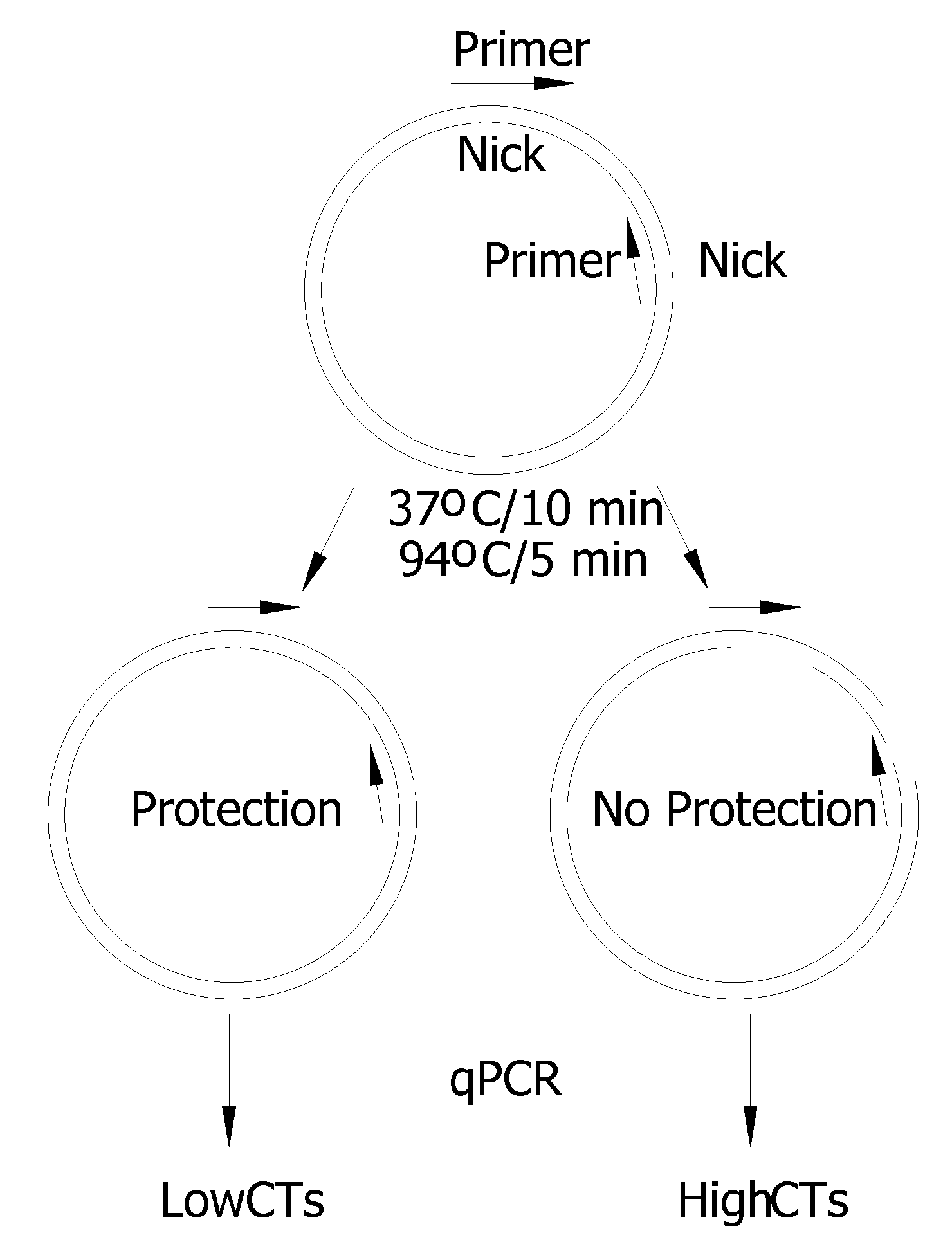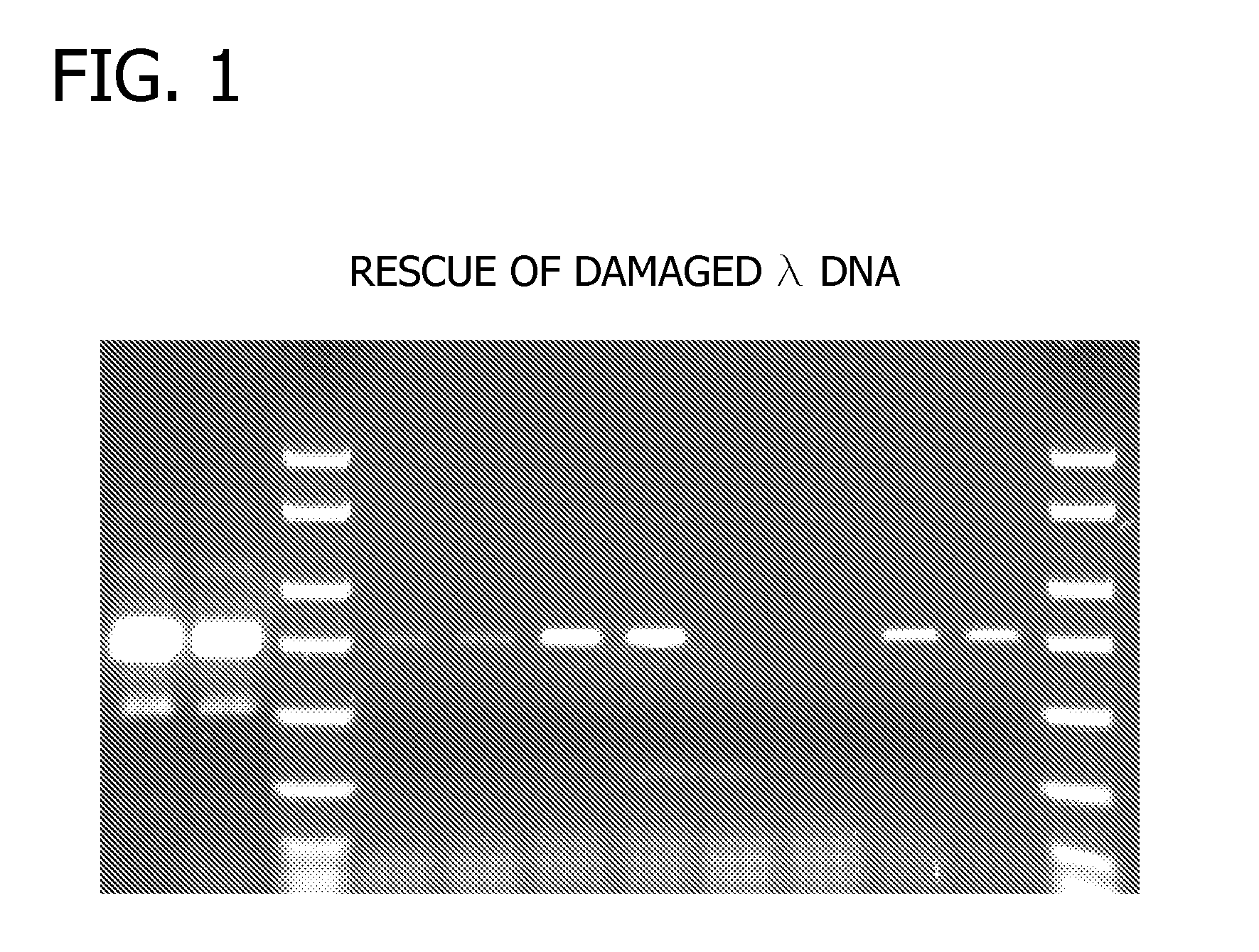Methods and Compositions for Amplification of DNA
a technology of dna and composition, applied in the field of compositions and methods for amplification of deoxyribonucleic acids, can solve the problems of pcr applications that require high fidelity dna synthesis, dna template damage from its original state, and inability to excise mis-inserted nucleotides
- Summary
- Abstract
- Description
- Claims
- Application Information
AI Technical Summary
Benefits of technology
Problems solved by technology
Method used
Image
Examples
example 1
Amplification Procedure
[0143]The following example shows a general procedure for rescue of damaged DNA with the Enzyme Blend. The procedure may be adjusted as needed to achieve the desired result. For example, the concentration of the Enzyme Blend, template DNA, primers, and MgCl2 may be adjusted, depending on the system being utilized. The following standard reagents listed in Table II were added to a thin-walled 200-μl or 500-μl heat-stable reaction vessel:
TABLE IIList of Standard ReagentsVolumeReagentFinal Concentration 5 μl10X Buffer for AccuTaq LA1XDNA Polymerase 1 μldNTP Mix (10 mM each)200 μM 1 μlTemplate DNA*5–6 ng / μl(5–6 ng / ul)40 μlWater— 1 μlEnzyme Blend ™2.5 units / μl48 μlTotal Volume
[0144]The mixture was mixed gently and briefly centrifuged to collect all components to the bottom of the vessel. The reaction was subject to the following standard reaction conditions listed in Table III:
TABLE IIIList of Standard Reaction ConditionsPREINCUBATION37°C.30–60minINITIAL DENATURATI...
example 2 sample preparation
[0146]This example demonstrates a sample preparation of the Enzyme Blend of the present invention. About 0.5 μl (2.5 units) of AccuTaq™ LA DNA polymerase, about 0.075 μl of 100 mM DTT, and about 0.5 μl (50 units) of AP endonuclease VI were added into a vessel and mixed together. About 1 μl of the resulting Enzyme Blend was used for each 50 μl total volume of the mixture for amplification. A scale-up preparation of the Enzyme Blend can be readily made and aliquoted into individual vessels. If the Enzyme Blend is used within two days, DTT is not used in the Enzyme Blend.
example 3
Damage of DNA Sample
[0147]A DNA sample can derive from a number of different sources (cells, tissues, etc.) and may have been damaged by a number of different ways (age, chemical exposure, light exposure, etc.). This example demonstrates that the Enzyme Blend rescued intentionally damaged DNA. The DNA sample was damaged by formic acid to recreate apurinic / apyrimidinic damage typically observed in DNA damaged by natural processes.
[0148]Lambda DNA was intentionally damaged by exposure to formic acid. The bottom of a spin column was broken off and placed in a disposable tube. The tube was centrifuged for 2 minutes at 3,000 RPM to form column. The tube was discarded. A mixture of 4 μl of λ DNA (2.5 ng / μl) was added to 20 μl 1× Tris-EDTA buffer and 10 μl of a 10× formic acid dilution (1 μl 96% Formic acid+10 μl H2O). The mixture was incubated at 37° C. for 10 min. After placement in the column, the mixture was centrifuged for 4 min. at 3,000 RPM. A microliter of Tris-EDTA buffer (100×, 0...
PUM
| Property | Measurement | Unit |
|---|---|---|
| pH | aaaaa | aaaaa |
| pH | aaaaa | aaaaa |
| temperature | aaaaa | aaaaa |
Abstract
Description
Claims
Application Information
 Login to View More
Login to View More - R&D
- Intellectual Property
- Life Sciences
- Materials
- Tech Scout
- Unparalleled Data Quality
- Higher Quality Content
- 60% Fewer Hallucinations
Browse by: Latest US Patents, China's latest patents, Technical Efficacy Thesaurus, Application Domain, Technology Topic, Popular Technical Reports.
© 2025 PatSnap. All rights reserved.Legal|Privacy policy|Modern Slavery Act Transparency Statement|Sitemap|About US| Contact US: help@patsnap.com



